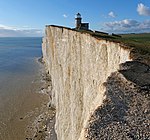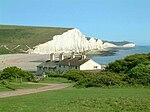East Dean and Friston
Civil parishes in East SussexNational Trust properties in East SussexPopulated coastal places in East SussexWealden District

East Dean and Friston is a civil parish in the Wealden District of East Sussex, England.The two villages in the parish are in a dry valley on the South Downs – between Eastbourne three miles (4.8 km) to the east and Seaford an equal distance to the west. The main A259 road goes through both village centres. The coast and much of the land between it and the A259 from the east edge of Seaford to the west edge of Eastbourne is owned by the National Trust, and this has prevented further development to the area. The civil parish was formed on 1 April 1999 from "East Dean" and "Friston" parishes.
Excerpt from the Wikipedia article East Dean and Friston (License: CC BY-SA 3.0, Authors, Images).East Dean and Friston
Friston Hill, Wealden East Dean and Friston
Geographical coordinates (GPS) Address Nearby Places Show on map
Geographical coordinates (GPS)
| Latitude | Longitude |
|---|---|
| N 50.76 ° | E 0.2 ° |
Address
Friston Hill
Friston Hill
BN20 0EA Wealden, East Dean and Friston
England, United Kingdom
Open on Google Maps









